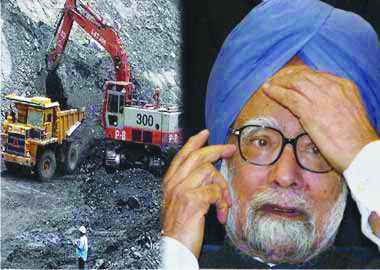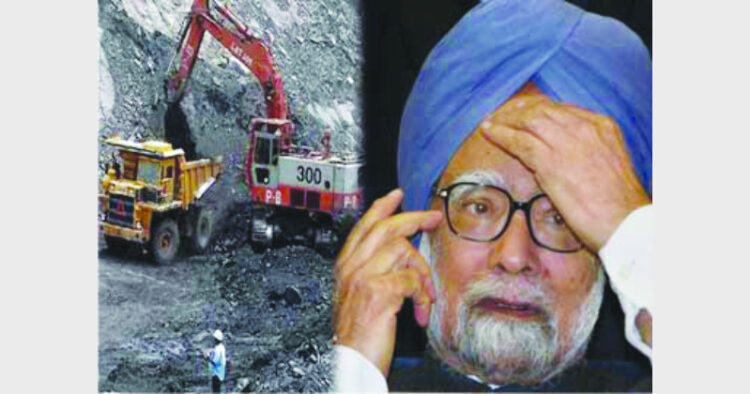
CAG nails UPA lie. Trident of corruption in coal, power and civil aviation hits UPA hard. Chorus for regime change grows louder
Dr R Balashankar
Resignation of Prime Minister Dr Manmohan Singh is the first among a series of steps the government should take in response to the CAG report on Coal. The ministry was headed by the Prime Minister during the period of the report. And hence, he is directly responsible for the decisions taken which led to the loss of Rs 1.86 lakh crore to the nation, going by modest estimates. In a vibrant functioning democracy, the Prime Minister is morally responsible for all actions, decisions, programmes and implementation of his government as he is the final authority in matters of governance.
The Congress party, leading the UPA has used the much abused personal integrity of Manmohan Singh to slip its way through various instances of corruption, plunder, maladministration and lack of governance. But in this case, the Prime Minister’s alleged image would not do, for, now, he is directly responsible as the Minister of Coal for the Arbitrary Allocation of Coal Mines to Industrial Houses, unverified bidders and non-conformity to rules. This is the worst manifestation of cronyism. It is not a stand alone aberration.
The Prime Minister cannot continue in office also because no meaningful discussion can take place in Parliament where his party members and allies would be “bound” to defend him. Impartial inquiry (UPA would not know what it means) cannot be done when the person being inquired into is the Prime Minister of the country. In name sake democracies these things can happen. The ruler orders a probe and gets himself exonerated. But India is still a strong democracy and hence the demand of the Opposition for the Prime Minister’s resignation is very valid. If the UPA and Manmohan Singh personally are so confident that no wrong doing has been done, let the Prime Minister step down in the interest of fair debate, discussion, inquiry and investigation. If found not guilty, nothing stops the Congress party from re-electing Singh.
The TV channels and the newspapers are demanding that the Opposition should go for a debate in Parliament on the CAG reports. They have tried to put the ball in the Opposition’s court, making it sound as though it is the Opposition and not the government that needs to explain their position. The media is seeking to divert attention from the CAG report to the impasse in Parliament. One has to only read the summary of each of the CAG report to realise that there is a prima facie, indisputable case of corruption. In the case of coal report, the onus is directly on the Prime Minister.
The UPA government under Manmohan Singh, with Sonia Gandhi as cahoots has set new levels in corruption, a record which is unlikely to be beaten by any government, anywhere in the world for all times to come. The three Comptroller and Auditor General (CAG) reports reluctantly tabled in Parliament this week have indicted the government, right up to the Prime Minister for several acts of wanton loot. The reports on Coal, Power and the Airports reveal a deep-set ennui in the government. An affliction of insatiable greed is eating into the public fund, tax payers’ money and national resources.
The CAG report on coal finds the scam bigger than the 2G scam. According to the report, the coal blocks allocations caused the exchequer a loss of Rs 1.86 lakh crore, much bigger than the 2G scam. This is only in relation to the private players. The losses from the PSUs would be calibrated separately.
India has a coal reserve of 285,863 million tonnes and half of India’s power needs are supplied from coal based plants. The CAG report has pointed out that the government gave away the coal blocks in a hurry, without following proper bidding process, citing the target ‘Power for All by 2012.’ (yes, 2012, this year). But in reality, the government reduced the target for power generation midway through the eleventh plan. Since 2004, 192 coal blocks were allotted. Out of these 86 coal blocks were to produce 73 million tonnes of coal by 2010-11. However, only 28 blocks, which included 15 allocated to the private sector could start production by March 2011 and produced only 34.64 million tonnes, that is less than fifty per cent of the target.
According to the CAG report the Ministry of Coal introduced Bank Guarantee in 2005, to ensure timely production. If any operator failed in reaching target production, their bank guarantee was to be encashed. Predictably, it was not done. At least 15 blocks had fallen back in production and in 2011 the bank guarantees lapsed and the government could not take the money because the modalities were still being worked out. In six years the government had not done that task. The net loss on this head is Rs 311.8 crore.
Despite explicit instruction from the allocation committees on keeping a distance from PSU mines and the private mines, the Coal Ministry allocated at least three mines that had a shared border, resulting in loss of minerals and mining years to the state companies. The Coal India Limited had requested for 138 blocks in August 2008 with a capacity of 57,570 tonnes. It scaled this down to 116 blocks with 49,790 tonnes a little later. Despite the CIL’s request not to de-serve mines, the ministry went ahead resulting in an immediate loss of employment to 400 people.
Sordid accounts of such losses abound in the report. The allotments were made when Prime Minister Manmohan Singh was the Coal minister. The PM reportedly ignored the then coal secretary”s advice to auction coal blocks. The report however does not mention the Minister/Prime Minister. It has been left for common sense deduction. Among the beneficiaries of the Rs 1.86 lakh crore loss to the nation are 25 firms including Essar Power, Hindalco, Tata Steel, Tata Power and Jindal Steel and Power. “The government could have tapped a part of this financial benefit by expediting decision on competitive bidding for allocation of coal blocks,” CAG said.
The report on the 16 Ultra Mega Power Projects is another string of sins. The government allotted the project to higher bidders though the lowest bidder was declared technically sound and capable. The criteria for the projects was kept rather low and the bid document was often changed and amended as per the feedback from the bidder! The government allotted excessive land for the projects—in two cases it was 1538 acres and 1096 acres— without assigning reason or specifying conditions for use. The post-bid concessions given to the Reliance Power Limited in Sasam gifted the company with benefits to the “tune of Rs 29,038 crore with a net present value of Rs 11,852 crore.” The tariff for power produced was fixed months before the EGOM met and recommended price fixing by bidding. The report has pointed out that there was gap in bid evaluation and the claims of the bidders were not verified.
The third report on DIAL (Delhi Airport) project is equally scandalous. The CAG has squarely accused the government and the Civil Aviation Ministry (till recently held by Praful Patel) of favouring the company GMR at the cost of the exchequer. The CAG has put the amount at Rs 3750 crore. DIAL is charging airport fee from each flyer, a provision not included in the contract.
The report also blamed the Airport Authority of India for acting against the interests of the government. The report said DIAL can potentially earn Rs 1,63,557 crore over a 60-year period from the land given to it on a lease of Rs 100 per annum. Allowing DIAL to levy Development Fee vitiated the sanctity of bidding process and led to undue benefit of Rs 3,415.35 crore to the private firm, it said.
GMR Infrastructure holds 54 per cent stake in Delhi International Airport Ltd (DIAL). Germany”s Fraport AG and Malaysia Airport Holdings are the other minority partners in the consortium that has operated the Delhi airport since 2006.”It was noticed that Ministry of Civil Aviation and Airport Authority of India, on some occasions, violated the provisions of the transaction documents in the interest of the concessionaire,” the official auditor said.














Comments